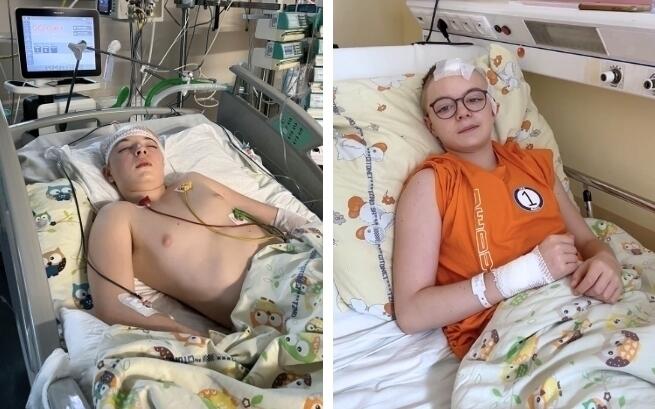A Family's Unimaginable Struggle: Krzyś’s Fight to Overcome a Stroke and Reclaim His Life
A stroke, a fight for survival, surgery, and countless hours spent in the hospital—how is it possible that all this happened to our son in just one month? Krzyś, an energetic, active boy, was full of life and joy until the evening of March 8, 2023. That night, everything changed in an instant.
My husband found Krzyś unconscious on the floor of his room. Panic set in as we rushed him to the hospital, unsure of what was happening to our precious child. What followed was a nightmare we could never have imagined. Doctors diagnosed Krzyś with a hemorrhagic stroke in the left hemisphere of his brain. The battle for his life began immediately, and we were left in a state of disbelief. Our son was placed on the operating table for four long hours. As the clock ticked, we could do nothing but wait, terrified of the outcome.

Once the surgery was over, Krzyś was admitted to the intensive care unit. The doctors’ prognosis was grim. They told us that, due to the extensive damage to his brain, Krzyś might not understand us or even be able to speak. Our hearts sank. But then, on the second day after the surgery, something miraculous happened—Krzyś woke up.
Though the miracle of his waking up was a blessing, the road ahead was anything but easy. The stroke caused severe damage to his body, leaving him with right-sided paralysis. Every day since has been a constant battle for mobility, as Krzyś struggles with movement and coordination. On top of this, he developed visual field defects and aphasia, a condition that makes communication incredibly difficult. His world, once filled with play and laughter, was now a place of uncertainty, struggle, and pain.
As parents, we have watched Krzyś face each day with courage and determination, despite the immense challenges. But the truth is, this fight is far from over. Every small step he takes toward recovery feels like a victory, but we know there’s a long road ahead before he can regain any semblance of the life he once knew. The recovery process is grueling, but with the right treatment and intensive rehabilitation, we hold on to hope.

Thanks to your generous support so far, we’ve been able to provide Krzyś with the treatment and rehabilitation he desperately needs. Without this support, his progress would not have been possible. Words cannot express how grateful we are for the kindness and generosity you’ve shown our family during this incredibly difficult time. However, the journey is far from complete, and Krzyś still needs your help.
Every day, Krzyś trains with specialists, fighting to regain the skills and abilities that the stroke took from him. This includes trips to rehabilitation camps, intensive therapy, and constant medical support. But all of this comes at a steep price, one that we struggle to meet. Despite doing everything we can to help Krzyś, the costs continue to rise, and we find ourselves asking for your continued support.
We believe that with your help, Krzyś can continue on his path to recovery. We dream of the day when his fight will end, when he will regain at least a part of his former life. Every donation, no matter how small, will help make this dream a reality. Your support means more to us than words can express. It is helping us provide Krzyś with the chance to heal, to walk, to speak, and to live without the heavy weight of his stroke.

As parents, we will continue to do everything in our power to help our son, but we cannot do it alone. Every penny you contribute will go toward Krzyś’s recovery—toward his rehabilitation, his therapies, and his future. Together, we can help Krzyś regain his strength and rebuild the life that the stroke tried to take from him.
From the depths of our hearts, thank you for your support, your kindness, and your belief in Krzyś’s journey. We know that with your help, he will keep fighting, and one day, he will walk again, talk again, and live the life he was meant to lead. Please, help us give Krzyś the future he deserves. Your generosity is making all the difference.
Service Dogs in the Spotlight: Why Theater Seats Are Part of Their Training

When most people think about service dog training, they imagine obedience drills, practice with harnesses, or navigating busy sidewalks. What they don’t expect is a row of dogs sitting politely in a theater, watching a musical unfold under flashing lights and booming sound. Yet, for many service dogs in training, this unlikely scenario is a crucial part of their preparation for the real world.
The test is simple but powerful: the dog must sit through an entire musical without making a sound or losing focus. Trainers explain that the theater environment provides a perfect storm of distractions—singing, music, applause, laughter, bright lights, and sudden movements. If a dog can remain calm and composed during a two-hour performance, they are far more likely to succeed when life throws unexpected challenges their way.

“The world is unpredictable,” one trainer explained. “A future service dog might need to stay steady while their partner navigates a crowded train station, a noisy street fair, or even a chaotic emergency situation. The theater allows us to recreate that unpredictability in a safe and controlled way.”
The sight of service dogs nestled quietly into theater seats has charmed audiences around the world. Photos shared online show Labradors, golden retrievers, and shepherds gazing at the stage with steady calm, ignoring the swirl of sound and motion around them. To the untrained eye, it might look adorable—dogs “watching a play.” But in truth, it’s a moment that represents years of hard work, discipline, and the quiet heroism of these remarkable animals.
For their future handlers, these tests are more than symbolic. A person living with vision loss may one day depend on a dog to lead them safely through a subway station filled with echoing noise and jostling crowds. A veteran coping with PTSD might rely on their dog to keep them grounded during fireworks or a sporting event. Parents of a child with autism may watch their dog calmly redirect a meltdown triggered by sensory overload. In all these cases, the animal’s ability to ignore distractions and remain focused is not just helpful—it can be life-changing.

One theater director described the day a group of service dogs attended a rehearsal. “The cast was a little nervous,” she recalled. “They’d never performed for an audience of dogs before. But afterward, they said it was the most respectful audience they’d ever had. The dogs didn’t move, didn’t bark—just sat calmly as though they understood this was their big test, too.”
Theaters themselves often welcome these unusual guests with open arms. For actors, it can be an honor to know that their work is helping to prepare dogs who will go on to transform lives. For audiences who happen to share the space, it can be a profound reminder of patience, loyalty, and the hidden work that goes into building independence for those who need it.
What resonates most is the deeper lesson these dogs embody. Long before they walk beside someone in need, service dogs learn to weather storms of sound and light without losing composure. They learn to stay still, to focus, and to tune out the chaos around them. In doing so, they teach us something about resilience.
Perhaps that is why these images spread so quickly online. They are more than cute pictures. They are glimpses into the quiet discipline that allows people to live fuller, freer lives with the help of their four-legged partners.
In a world that often feels overwhelming, the calm presence of a dog in a theater seat reminds us that focus and patience are not just virtues for animals in training—they are lessons we can all carry with us.





